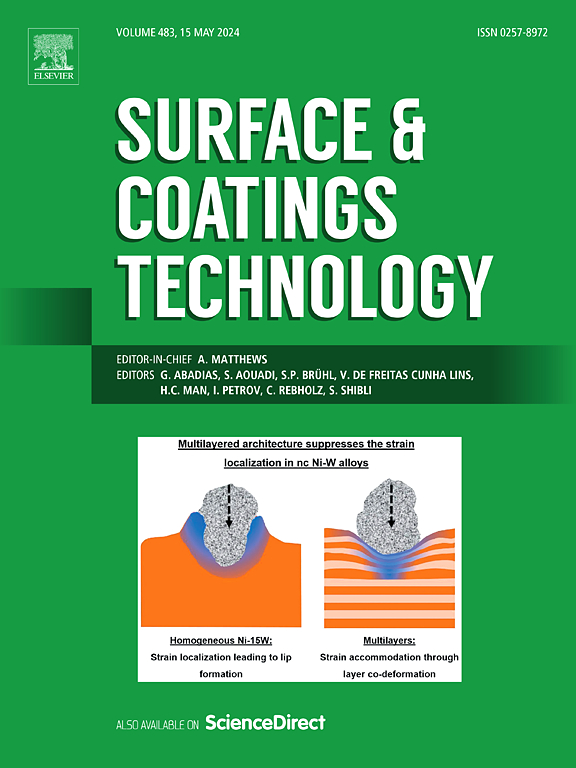Study on self-healing electrophoretic composite coatings on magnesium alloys: Modification mechanism of cerate and its influence
IF 5.3
2区 材料科学
Q1 MATERIALS SCIENCE, COATINGS & FILMS
引用次数: 0
Abstract
The conversion film is essential before electrophoresis (EP) for adhesion strength and corrosion resistance. In this study, the conventional phosphate conversion film (P film) was modified by a short one-step method to prepare a Ce-modification conversion film (P/Ce film) on AZ31 Mg alloy. The modification process of the conversion film was revealed by X-ray photoelectron spectroscopy (XPS) combined with thermodynamic deposition phase diagrams. The corrosion resistance and adhesion strength were evaluated by electrochemical tests and pull-off tests. The results show that Mn ions in the P film are replaced in situ by Ce ions in a suitable pH range. The P/Ce film is dense and free of cracks, with a uniform distribution of Ce elements, and also exhibits enhanced corrosion resistance and self-healing performance. Furthermore, the adhesion strength of the P/Ce-EP coating is improved by 39.29 %, and the coating resistance (Rf) is enhanced by approximately one order of magnitude compared to the P-EP coatings.
镁合金自愈电泳复合涂层的研究:铈酸盐的改性机理及其影响
转换膜是电泳(EP)前必不可少的附着力和耐腐蚀性。本研究采用一步法对常规磷酸盐转化膜(P膜)进行改性,制备AZ31镁合金上的Ce改性转化膜(P/Ce膜)。利用x射线光电子能谱(XPS)结合沉积热力学相图揭示了转化膜的改性过程。通过电化学试验和拉拔试验对其耐蚀性和粘接强度进行了评价。结果表明,在合适的pH范围内,P膜中的Mn离子在原位被Ce离子取代。P/Ce膜致密无裂纹,Ce元素分布均匀,具有较好的耐腐蚀性能和自愈性能。与P- ep涂层相比,P/Ce-EP涂层的结合强度提高了39.29%,涂层阻力(Rf)提高了约一个数量级。
本文章由计算机程序翻译,如有差异,请以英文原文为准。
求助全文
约1分钟内获得全文
求助全文
来源期刊

Surface & Coatings Technology
工程技术-材料科学:膜
CiteScore
10.00
自引率
11.10%
发文量
921
审稿时长
19 days
期刊介绍:
Surface and Coatings Technology is an international archival journal publishing scientific papers on significant developments in surface and interface engineering to modify and improve the surface properties of materials for protection in demanding contact conditions or aggressive environments, or for enhanced functional performance. Contributions range from original scientific articles concerned with fundamental and applied aspects of research or direct applications of metallic, inorganic, organic and composite coatings, to invited reviews of current technology in specific areas. Papers submitted to this journal are expected to be in line with the following aspects in processes, and properties/performance:
A. Processes: Physical and chemical vapour deposition techniques, thermal and plasma spraying, surface modification by directed energy techniques such as ion, electron and laser beams, thermo-chemical treatment, wet chemical and electrochemical processes such as plating, sol-gel coating, anodization, plasma electrolytic oxidation, etc., but excluding painting.
B. Properties/performance: friction performance, wear resistance (e.g., abrasion, erosion, fretting, etc), corrosion and oxidation resistance, thermal protection, diffusion resistance, hydrophilicity/hydrophobicity, and properties relevant to smart materials behaviour and enhanced multifunctional performance for environmental, energy and medical applications, but excluding device aspects.
 求助内容:
求助内容: 应助结果提醒方式:
应助结果提醒方式:


